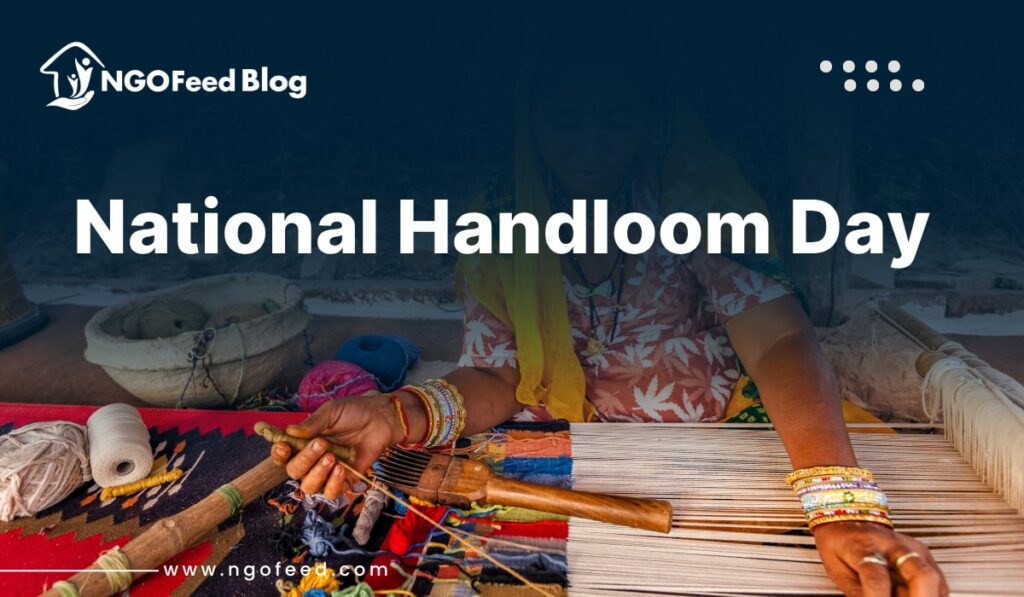Observed as National Handloom Day in India every year on 7 August, it honors the ageless beauty, legacy, and financial importance of the handloom industry. More than only clothing, handloom weaving is deeply ingrained in India’s cultural fabric, representing tales, customs, and livelihoods transferred throughout generations.
National Handloom Day honors the millions of weavers all around the nation whose skill preserves India’s native textile traditions, not just a celebration. By inspiring the public to back local artisans and time-honored craft, this celebration also encourages self-reliance, sustainability, and ethical fashion.
Table of Contents
National Handloom Day – Historical Context
Prime Minister Narendra Modi’s declaration first honored National Handloom Day on 7 August 2015 at a Chennai celebration. The day marks the start of the Swadeshi Movement in 1905 throughout India’s fight for independence. The movement wanted to inspire Indians to stop buying foreign goods, especially British textiles, and instead boost local, indigenous companies including handloom weaving.
Also Read: Role of NGOs in Combating Plastic Pollution
Revival of Indian tiny enterprises depended mostly on the Swadeshi movement. Particularly under the direction of Mahatma Gandhi, Khadi and handwoven materials came to represent self-sufficiency, independence, and national pride. Celebrating National Handloom Day on this day strengthens that sense of cultural revival and financial independence.
National Handloom Day 2025 – Targets and Goals
Celebrations of National Handloom Day serve several critical functions:
- To appreciate and honour handloom weavers for their contribution in preserving India’s cultural and financial legacy.
- Encourage individuals to favor handloom over machine-made goods by raising knowledge of handwoven textiles.
- Increasing the demand for handloom items will help to empower rural and traditional weavers.
- To generate enthusiasm for environmentally friendly, sustainable fashion among young people and consumers.
- Through support for indigenous businesses, to advance the concepts of “Vocal for Local” and “Atmanirbhar Bharat.”
Also Read: Role of NGOs in Refugee Support
National Handloom Day Themes from Recent Years
Every year the government and stakeholders declare a theme consistent with national goals:
- Encouraging pride in Indian handwoven goods under “My Handloom My Pride“
- Encouraging modern application of traditional skills, handmade for the twenty-first century
- “Weaving a Sustainable Future”: Emphasizing handloom’s environmental worth
- “Atmanirbhar Bharat by way of Handloom: Supporting self-reliant rural economies”
Importance of the Handloom Sector in India
India’s handloom industry is one of the oldest and largest cottage industries in the world. It is crucial for the country’s economy, culture, and sustainability:
1. Employment and Rural Economy
- Employs over 35 lakh people, including a high percentage of women weavers, particularly in northeastern and southern India.
- Provides sustainable livelihoods in rural and semi-urban areas.
Also Read: The Role of UNICEF in Menstrual Health and Hygiene
2. Cultural and Regional Identity
Every state in India has its unique weaving traditions:
- Pochampally Ikat (Telangana)
- Chanderi and Maheshwari (Madhya Pradesh)
- Banarasi Silk (Uttar Pradesh)
- Jamdani (West Bengal)
- Patola (Gujarat)
- Kanjeevaram (Tamil Nadu)
These are not just fabrics, but symbols of identity, artistry, and regional pride.
3. Eco-Friendly and Sustainable
- Handloom weaving uses minimal electricity, emits no pollutants, and promotes slow fashion.
- It is zero-carbon, biodegradable, and encourages conscious consumerism.
4. Women Empowerment
- Women form the backbone of the handloom workforce.
- The industry enables financial independence and preserves intergenerational skill transfer.
Also Read: NGOs in Authoritarian Regimes
Government Schemes and Initiatives
The Ministry of Textiles has introduced various schemes to boost the handloom sector:
- National Handloom Development Programme (NHDP)
- Handloom Mark Scheme – To ensure product authenticity
- India Handloom Brand – For high-quality marketing and global promotion
- e-Dhaga App – For digital transactions and raw material supply
- Cluster Development Projects and skill training programs
- These initiatives aim to modernize infrastructure, digitally empower weavers, and connect artisans to larger markets.
National Handloom Day 2025 Celebrations and Observances
Across the country, National Handloom Day is celebrated through:
- Exhibitions and Handloom Expos showcasing regional weaves
- Award ceremonies honoring exceptional weavers
- Design workshops and fashion shows involving students and professionals
- Awareness campaigns on social media using hashtags like #MyHandloomMyPride, #VocalForLocal, and #SupportWeavers
- Collaborations with schools, colleges, NGOs in India, and cooperatives to promote cultural learning and handloom pride
Also Read: How LGBTQ+ Rights NGOs Navigate Hostile Regions
Role of NGOs and Civil Society in National Handloom Day
NGOs play a key role in:
- Organizing weaver cooperatives and women’s self-help groups
- Promoting fair trade and ethical fashion
- Hosting skills development workshops
- Building awareness through storytelling, digital campaigns, and artisan exhibitions
- Supporting market linkage and design innovation
What You Can Do to Support Handloom
As a citizen or organization, you can contribute by:
- Purchasing handloom products for personal and gifting use
- Promoting Indian weaves through social media and word-of-mouth
- Hosting handloom days at schools, workplaces, or events
- Encouraging young designers to work with artisans
- Visiting handloom exhibitions and promoting local weavers
Also Read: ESG and NGOs: How Nonprofits Are Shaping Corporate Sustainability
“Handloom is not just a fabric—it is a reflection of India’s soul.”
— Ministry of Textiles, India
Conclusion
National Handloom Day is a call to appreciate and protect India’s living textile traditions. It reminds us that handloom is not a thing of the past—it is the future of sustainable fashion, local enterprise, and cultural pride. By embracing handloom, we support not just artisans but also a larger movement of self-reliance, dignity of labor, and preservation of heritage.
Let us celebrate India’s weavers and wear our culture with pride—on 7 August and every day.
Frequently Asked Questions (FAQ)
What is National Handloom Day?
National Handloom Day is observed every year on 7 August to recognize and honor the contribution of handloom weavers in India and to promote the use of handwoven Indian textiles.
Why are 7 August chosen as National Handloom Day?
The date marks the beginning of the Swadeshi Movement in 1905, which encouraged Indians to boycott foreign goods and revive indigenous industries, especially handlooms.
When was National Handloom Day first celebrated?
It was first observed on 7 August 2015, launched by the Government of India under the Ministry of Textiles.



